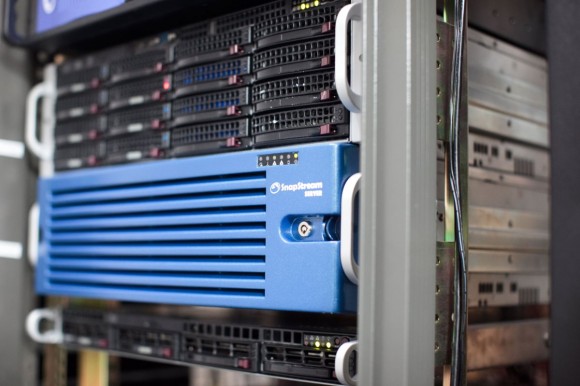
We’ve covered SnapStream since just about Day 1 here at ZNF and, along the way, struck up a friendship with CEO Rakesh Agrawal – someone we highly respect and enjoy regularly running into at trade show cab lines. As the story goes, SnapStream very successfully pivoted from hobbyist HTPC solution (BeyondTV) to professional grade TV monitoring… with The Daily Show as an early, notable customer. Consisting of terabytes of storage, television transcription, and multi-pane viewing these guys offer all sorts of compelling business intelligence tools and Ars Technica recently visited their Houston office for an exposé worth checking out:
With 30 tuners and 30 TB of storage, SnapStream makes TiVos look like toys
SnapStream’s enterprise DVR clusters together multiple capture servers that all pool together their storage. The servers run Windows Server 2008R2 and the proprietary SnapStream application, and they each contain a stack of hard disk drives in a RAID 5 4+1 configuration. The SnapStream application uses Microsoft SQL Server for storing metadata, and recorded video files are stored on the NTFS-formatted file system as regular files. Larger customers can also use existing SAN or NAS systems […] Video is typically ingested into the SnapStream DVRs directly from a cable feed at 480p, 720p, or 1080i through component inputs on heavy-duty QAM capture cards, thus bypassing the need for CableCard
I loved Beyond TV but the lack of Cable Card support killed the Beyond TV as a valid consumer solution.
Back in those days, companies had to pay lots to CableLabs to get certified. Maybe $30k or $50k? Nowadays companies can self certify which is more practical, although it’s still probably a complex, niche technology that remains a bitch for the various reasons we’ve previously discussed here.
Had one of these at last job. We were trying to allow live TV in classrooms once Comcast killed analog and as a result all of our COAX + Analog tuner investment. The major problem with our box was it couldn’t do live transcoding so everything went out at 10 Mb/s MPEG-2 stream the older capture cards did. In a 802.11g or even highly used 802.11n multiple streams of that size were tough to impossible. We looked at newer boxes for QAM and such but there was zero upgrade path. We had to just throw away $25K investment and start over.
If I was doing it now. I would get high end PC with some silicondust or ceton tuners running Myth. You can do almost everything they are doing at 20% cost and not rely upon analog hole or cable QAM channel mappings.
This solution is great if you are the daily show and want to record all the news networks, CSPAN and majors so you can text search of Closed Caption data for keywords. Otherwise it just is overkill and too expensive.
If they lowered the cost and allowed for external cable card tuners maybe but otherwise nope.
NEW TiVo Roamio Ultimate released
* record 30 shows at once up to 4,500 HD hours
* only $129.99 plus service
The critic reviews all hail TiVo as an innovator and stock price hits all time high. The fastest selling tech item of all time!
TiVo user community reactions?
‘Way too expensive. That’s $30 more than a RoKu! Ridiculous.’
‘The remote doesn’t light up! For $130 are they kidding me?’
‘I’d upgrade from my TiVo 1 but TiVo won’t give me one for free!’
‘Doesn’t have [some minor feature] so TiVo sucks’
‘One word. No Android support’
:-)
I am holding out for Android streaming support of all 30 HD feeds…… at once
“And SnapStream let me know that they currently have no private individuals as customers—no crazy billionaires with SnapStream systems in their crazy billionaire mansions”
That’s too bad. If I had to choose between a yacht and a SnapStream, I’d go with the SnapStream. Seems like it’d be a damn fun toy.
And unlike TiVo, they might even ship it with a learning remote…
Fascinating. I always wondered what system The Daily Show was using to get video recordings.